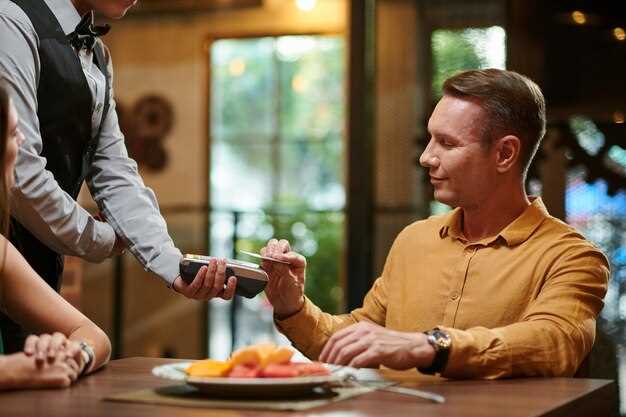Begin by understanding your customers’ preferences to create a loyalty program that resonates. Analyzing customer behavior and purchase history allows you to tailor rewards that speak directly to their desires. For instance, offering personalized incentives based on their favorite dishes or ordering habits can significantly enhance engagement.
Integrate a seamless digital platform for your loyalty program. A mobile app or online system can make tracking and redeeming points effortless for customers. Simplifying the process not only increases program participation but also provides valuable data for optimizing your offerings.
Boost retention by creating a tiered loyalty system. Offer escalating rewards as customers climb higher tiers, encouraging them to remain active and spend more. This strategy not only increases customer lifetime value but also enhances their emotional connection to your brand, leading to longer-lasting loyalty.
Engage customers through exclusive experiences. Invite loyal members to special events or offer them early access to new menu items. These experiences create a sense of community and privilege, reinforcing their allegiance to your restaurant.
Structuring Your Loyalty Program for Maximum Engagement

Craft incentives that directly align with what your customers value most. Begin by identifying your most popular dishes or services and use them as rewards. This ensures customers feel appreciated and understood, which boosts engagement.
- Tiered Rewards System: Develop a tiered system where customers earn points per purchase, unlocking higher-value rewards as they progress. This structure creates a sense of progression and motivates continued patronage.
- Personalized Offers: Harness data analytics to send tailored offers based on customer preferences and past behaviors. Personalized rewards make the program feel exclusive and relevant.
- Time-Limited Rewards: Integrate limited-time offers into your program to create urgency. Guests are more likely to redeem rewards quickly, increasing spending within a designated period.
- Social Sharing Incentives: Encourage customers to share their purchases or reviews on social media in exchange for points or discounts. This not only engages the customer but also serves as organic marketing.
- Referral Bonuses: Implement a referral system where existing members receive bonuses for bringing in new customers. Word-of-mouth can be a powerful tool for expanding your customer base.
Regularly update the rewards based on customer feedback and behavior data. This dynamic approach keeps the program fresh and aligned with changing preferences, ensuring sustained enthusiasm and participation long-term.
Choosing the Right Rewards for Your Audience
Prioritize understanding your customer demographics to tailor rewards precisely to their preferences. Conduct surveys or analyze purchasing data to create a profile of your typical guest. Armed with this information, align reward offerings with their interests.
Offer a mix of incentives such as discounts, free items, or exclusive experiences. For example, if your data indicates a youth-dominated clientele, consider partnerships with local entertainment venues or tech gadget raffles. Conversely, older patrons might appreciate fine dining experiences or wine tastings.
Implement a tiered reward system to motivate repeated visits. For instance, create levels like “Bronze,” “Silver,” and “Gold,” with escalating benefits at each stage. Use table below for clarity:
| Tier | Requirements | Benefits |
|---|---|---|
| Bronze | 5 Visits | 5% Off Next Order |
| Silver | 10 Visits | Free Dessert with Meal |
| Gold | 20 Visits | Exclusive Event Invitation |
Keep rewards dynamic by rotating offers to maintain excitement. Regularly review reward performance and seek feedback to refine offerings. Personalize communication through email or mobile apps for a tailored loyalty experience, boosting engagement and satisfaction.
Designing a Seamless User Experience
Prioritize mobile compatibility for your loyalty program, ensuring that users can easily access perks and track points on their devices. Create an intuitive app interface with clear navigation, allowing customers to redeem rewards with just a few taps. Streamline registration by enabling sign-up through social media accounts or a simple email entry, reducing barriers to entry.
Focus on personalization by using data analytics to tailor offers based on individual purchasing patterns. For example, offer a special discount on a customer’s favorite dish on their birthday. This not only makes the customer feel valued but also increases engagement with your program.
Integrate feedback loops in the app so users can easily provide input on their experience. Prompt responses to feedback, coupled with transparent updates, demonstrate your commitment to customer satisfaction. Encourage participation by providing small incentives for feedback submissions, such as extra loyalty points.
Create a visually appealing interface that aligns with your brand’s identity. Use colors, fonts, and imagery that reflect your restaurant’s atmosphere to build a stronger emotional connection with users. Ensure the app’s loading times are minimal to maintain a smooth experience without frustrations.
Lastly, ensure security and privacy are top priorities. Display clear privacy policies and offer secure payment options within the app to build trust. When customers feel secure, they are more likely to engage frequently with the loyalty program, leading to increased retention and brand loyalty.
Incorporating Mobile and Digital Platforms
Integrate a user-friendly mobile app that allows customers to easily check their loyalty points, rewards, and exclusive offers. Utilize push notifications to remind them about unused rewards or upcoming promotions, enhancing engagement. Create seamless integration between the app and your restaurant’s ordering system, allowing users to place orders, book tables, or make special requests directly through their smartphones.
Leverage digital wallets such as Apple Pay or Google Pay for collecting and redeeming loyalty points. This not only simplifies the process but also appeals to tech-savvy customers who prefer contactless solutions. Encourage app downloads by offering immediate incentives such as a discount on their next purchase or complimentary items upon registration.
Consider incorporating gamification elements, like challenges or milestones, where customers can earn badges or additional points. This encourages more frequent visits and enhances the overall customer experience. Provide personalized recommendations and offers based on their purchase history with the help of AI-driven analytics, making their experience more tailored and rewarding.
Balancing Financial Sustainability with Customer Satisfaction
Enhance your restaurant’s loyalty program by strategically segmenting your customer base. Target high-value customers with exclusive offers that increase their average spend, such as special event invitations or premium menu tastings. This selective approach maximizes profitability while ensuring these key patrons feel valued.
Offering a point-based reward system, where diners earn points based on their expenditure, motivates increased spending. Design the rewards to entice, like free meals or discounts on future visits, ensuring they align with your profit margins. Analyze data regularly to adjust thresholds, keeping rewards attainable yet supportive of financial health.
Communicate transparently with customers about updates or changes in the loyalty scheme, highlighting improvements. This openness builds trust and understanding that any adjustments aim to enhance their experience and maintain the restaurant’s quality standards.
Finally, periodically survey your patrons to gauge satisfaction with the loyalty program. Incorporate their feedback to refine and optimize offerings, keeping retention high and your establishment financially robust.
Creating Tiered Loyalty Systems for Different Customer Segments
Implement a tiered loyalty program by categorizing customers based on their spending habits and dining frequency. Start by analyzing customer data to identify distinct segments such as occasional diners, regular patrons, and high-spending enthusiasts. This allows for customized rewards that cater specifically to each group’s preferences and encourage increased engagement.
For occasional diners, focus on offering incentives that drive more frequent visits. Consider providing discounts or small rewards after a certain number of visits within a specific time frame. This tactic not only attracts increased visits but also familiarizes infrequent guests with your menu and services.
Regular patrons deserve acknowledgment for their consistent support. Offer them rewards that enhance their dining experience, such as complimentary appetizers, priority seating, or personalized menu recommendations. Recognizing their loyalty in meaningful ways can further solidify their commitment to your establishment.
For high-spending enthusiasts, elevate their experience with exclusive perks. These might include invitations to special events, previews of new menu items, or access to a dedicated concierge service. Such premium offerings not only reinforce their status but also incentivize them to maintain or even increase their spending.
| Customer Segment | Reward Strategy |
|---|---|
| Occasional Diners | Discounts or small rewards for frequent visits |
| Regular Patrons | Complimentary appetizers, priority seating, personalized recommendations |
| High-Spending Enthusiasts | Invitations to events, menu previews, concierge services |
The key is to align the rewards with what each segment values most. Regularly assess the program’s effectiveness by gathering feedback and analyzing performance metrics. This ongoing assessment ensures that your tiered loyalty system remains impactful and relevant to your audience.
Strategies to Promote and Sustain Customer Loyalty

Prioritize personalized experiences by utilizing collected data to tailor rewards and communication. Implement a points-based system where customers earn points for each purchase, which can be exchanged for discounts or free items. This not only incentivizes spending but also encourages regular visits.
Regular engagement is crucial; send timely updates about new offerings or special events through preferred channels like email or app notifications. Encourage customers to join a VIP club, offering exclusive perks such as early access to new dishes or invitation-only events. This enhances their sense of belonging and encourages repeat patronage.
Create an emotional connection by supporting a local cause or charity, aligning your restaurant with something that matters to your clientele. Customers are more likely to be loyal if they feel their spending contributes to a positive impact.
Consistently gather feedback through surveys or short questionnaires offered at the end of a meal. Analyze this data to improve services and address any shortcomings, demonstrating a commitment to customer satisfaction.
Partner with local businesses for joint promotions. This not only extends your reach but also introduces your restaurant to new potential customers who may already be loyal to a partner business. Collaborations can include discount cards or special event pairings, offering a dual incentive.
Celebrate customer milestones, such as birthdays or anniversaries, with personalized offers or small tokens of appreciation, creating memorable experiences that strengthen loyalty.
Utilizing Personalization to Enhance Customer Connection
Begin by gathering detailed information about your customers, such as their dining preferences, special occasions, and past interactions. Use this data to tailor exclusive promotions and offers that align with their interests. For example, if a customer frequently orders vegan dishes, send them a personalized offer for a new plant-based menu item. This approach not only shows that you value their preferences but also encourages repeat visits.
Segment your customers based on their behavior and demographics, then create targeted marketing campaigns. Sending a personalized birthday discount to loyal customers or a special event invitation can significantly increase engagement. When customers feel recognized and appreciated, they are more likely to develop a strong emotional connection with your brand.
Integrate your loyalty program with modern technology by using a mobile app that allows customers to track rewards and receive personalized notifications. Push notifications can remind them of soon-to-expire points or special trading days, ensuring they stay actively engaged with your brand.
Ensure your staff is trained to recognize returning customers and make personalized recommendations based on their previous orders. This human touch can make all the difference in creating a welcoming and inclusive atmosphere.
Finally, encourage feedback and make use of it to further personalize your offerings. If a customer shows interest in sharing their opinion, it suggests a deeper level of engagement. Actively incorporate their suggestions into your menu or services to demonstrate that their voice matters.
Implementing Gamification to Boost Engagement
Incorporate challenges that encourage customers to try new menu items. Create a point system where each new dish tried earns points, leading to a reward. This not only incentivizes diverse menu exploration but also keeps the dining experience exciting.
- Offer tiered rewards. Create multiple levels of rewards and status based on points collected. For example, reaching Bronze, Silver, and Gold levels for certain point thresholds can motivate customers to engage more.
- Introduce time-sensitive competitions. Host seasonal or monthly challenges where customers can compete for exclusive rewards, such as a chef’s special dinner or a backstage kitchen tour.
- Utilize social sharing incentives. Encourage customers to share their achievements on social media by offering bonus points or discounts for posts. This not only enhances user engagement but also serves as organic marketing.
- Integrate a loyalty app with engaging features. Create personalized achievements and virtual badges that customers can earn for various actions like visiting the restaurant on special occasions or bringing friends along.
Analyze customer behavior data to refine gamification elements and ensure they align with customer interests and restaurant goals. Continuously update the program based on user feedback to maintain interest and engagement.
Monitoring and Analyzing Program Performance Metrics
Focus on tracking key performance indicators (KPIs) to understand how well your restaurant loyalty program is working. Start by setting specific goals like increasing repeat customer visits or boosting the average spend per guest. Use the following tactics to monitor and analyze data efficiently:
- Customer Retention Rate: Measure the percentage of returning customers over a set period. A high retention rate indicates a successful loyalty strategy.
- Redemption Rate: Keep an eye on how often members redeem rewards. A low redemption rate might signal that the rewards are unattractive or too difficult to redeem.
- Average Spend Per Visit: Track changes in spending habits of loyalty members compared to new or non-member customers. Positive shifts can highlight the program’s influence.
- Enrollment Growth Rate: Evaluate how quickly new customers are joining the loyalty program. A steady increase suggests that the program is appealing to new patrons.
- Customer Feedback: Use surveys and feedback forms to gather qualitative data. Understand what members like or dislike, and use this input to refine the program.
- Net Promoter Score (NPS): Track the likelihood of your customers recommending your program. This score is a direct indicator of customer satisfaction and loyalty.
Utilize analytics tools that offer visualizations and easy interpretations of these metrics to quickly identify trends and opportunities for improvement. Regularly reviewing these metrics will ensure that your loyalty program continues to meet its objectives and delights your most valued customers.
Video:

Boost Restaurant Loyalty in Minutes with This Strategy! (Do This First!)
Boost Restaurant Loyalty in Minutes with This Strategy! (Do This First!)
Q&A:

What are some innovative strategies to enhance customer loyalty in restaurants?
Implementing a robust loyalty program is a great way to boost customer retention. Restaurants can use mobile apps to offer personalized promotions based on customer preferences and purchase history. Gamification elements, like earning points that unlock rewards after frequent visits, can enhance engagement. Additionally, partnering with local businesses for cross-promotions can expand the customer base and add value to the rewards offered.
How can a restaurant measure the success of its loyalty program?
Metrics such as increased frequency of customer visits, higher average spend per visit, and the number of new members joining the program can be instrumental in assessing a loyalty program’s success. Customer feedback and surveys can provide qualitative insights into what aspects of the program are resonating. Tracking redemption rates of rewards and analyzing patterns in customer behavior are also critical to understanding the program’s impact on customer retention.
What common mistakes should restaurants avoid when designing a loyalty program?
One common mistake is overcomplicating the program rules, which can deter customer participation. Additionally, setting rewards that are not perceived as valuable by the customers can lead to disengagement. It’s important to ensure that the incentives align with customer desires and that the process of earning and redeeming rewards is straightforward. Another pitfall is failing to promote the program effectively, which can limit its reach and effectiveness.
How can technology improve restaurant loyalty programs?
Technology can significantly enhance loyalty programs by providing seamless user experiences through mobile apps or digital platforms. This approach allows customers to easily track their rewards, receive targeted offers, and interact with the program in real-time. Automation also plays a role by using data analytics to personalize promotions and improve customer engagement. Additionally, incorporating social media integration can amplify the program’s visibility and attract new participants through social sharing features.
Are there any successful examples of restaurant loyalty programs that have significantly increased customer retention?
Yes, several restaurants have successfully boosted customer retention through well-crafted loyalty programs. For instance, Starbucks’ Rewards program is often highlighted for its effective use of mobile technology and personalized offers. Customers earn stars for purchases, which can be redeemed for free items. The program’s mobile app provides a convenient way to engage customers, with features such as mobile ordering and payments. The chain’s ability to create a personalized experience has significantly contributed to its high customer retention rates.


